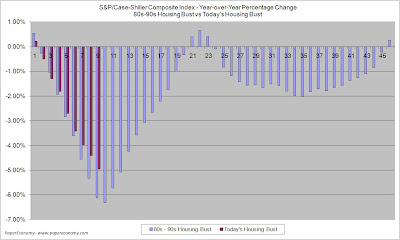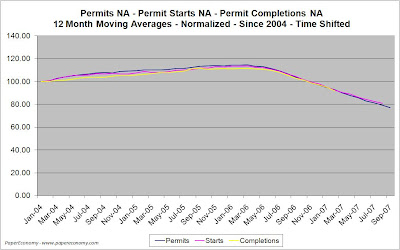
Quick! Head for the hills!
Oh well, look at it this way…
He may devalue your currency and even make you pay through the nose for food and fuel but at least he’s not sucking your blood!... yet!
BOO!
Happy Halloween from PaperEconomy!
 Today, the Bureau of Economic Analysis (BEA) released their first installment of the Q3 2007 GDP report showing a better than expected growth rate of 3.9%, buoyed by strength in, among other things, nonresidential structures, outstanding exports of goods, and federal, state and local government spending while continuing to be weighed down by tremendous weakness to fixed residential investment.
Today, the Bureau of Economic Analysis (BEA) released their first installment of the Q3 2007 GDP report showing a better than expected growth rate of 3.9%, buoyed by strength in, among other things, nonresidential structures, outstanding exports of goods, and federal, state and local government spending while continuing to be weighed down by tremendous weakness to fixed residential investment.
 The Mortgage Bankers Association (MBA) publishes the results of weekly applications survey that covers roughly 50 percent of all residential mortgage originations and tracks the average interest rate for 30 year and 15 year fixed rate mortgages as well as application volume for both purchase and refinance applications.
The Mortgage Bankers Association (MBA) publishes the results of weekly applications survey that covers roughly 50 percent of all residential mortgage originations and tracks the average interest rate for 30 year and 15 year fixed rate mortgages as well as application volume for both purchase and refinance applications. The following chart shows the average interest rate for 30 year and 15 year fixed rate mortgages over the last number of weeks (click for larger version).
The following chart shows the average interest rate for 30 year and 15 year fixed rate mortgages over the last number of weeks (click for larger version). The following charts show the Purchase Index, Refinance Index and Market Composite Index since January 2007 (click for larger versions).
The following charts show the Purchase Index, Refinance Index and Market Composite Index since January 2007 (click for larger versions).



 What’s most interesting about this particular comparison is that it highlights how young the current housing decline is, having only posted four consecutive year-over-year (YOY) monthly declines to home prices.
What’s most interesting about this particular comparison is that it highlights how young the current housing decline is, having only posted four consecutive year-over-year (YOY) monthly declines to home prices. The “peak” chart compares the percentage change, comparing monthly CSI values to the peak value seen just prior to the first declining month all the way through the downturn and the full recovery of home prices.
The “peak” chart compares the percentage change, comparing monthly CSI values to the peak value seen just prior to the first declining month all the way through the downturn and the full recovery of home prices. In this way, this chart captures ALL months of the downturn from the peak to trough to peak again.
In this way, this chart captures ALL months of the downturn from the peak to trough to peak again.















 The following chart shows the average interest rate for 30 year and 15 year fixed rate mortgages over the last number of weeks (click for larger version).
The following chart shows the average interest rate for 30 year and 15 year fixed rate mortgages over the last number of weeks (click for larger version). The following charts show the Purchase Index, Refinance Index and Market Composite Index since January 2007 (click for larger versions).
The following charts show the Purchase Index, Refinance Index and Market Composite Index since January 2007 (click for larger versions).


 Yesterday, the Massachusetts Association of Realtors (MAR) released their Existing Home Sales Report for September 2007 showing a slight bump in the road for president Doug Azarian’s purported two month long winning streak of increasing home sales.
Yesterday, the Massachusetts Association of Realtors (MAR) released their Existing Home Sales Report for September 2007 showing a slight bump in the road for president Doug Azarian’s purported two month long winning streak of increasing home sales. Whereas last month I speculated that we were at a crossroads of perception and information, I believe with September’s results we have firmly crossed over to the new reality of virtually non-existent (or ridiculously costly and inaccessible… take your pick) Jumbo and No-Doc loans.
Whereas last month I speculated that we were at a crossroads of perception and information, I believe with September’s results we have firmly crossed over to the new reality of virtually non-existent (or ridiculously costly and inaccessible… take your pick) Jumbo and No-Doc loans.
 The “year-over-year” chart compares the percentage change, on a year-over-year basis, to the BOXR from the last positive value through the decline to the first positive value at the end of the decline.
The “year-over-year” chart compares the percentage change, on a year-over-year basis, to the BOXR from the last positive value through the decline to the first positive value at the end of the decline. I wanted to make sure that everyone was aware of a number of truly huge home actions occurring around the country in the next few weeks.
I wanted to make sure that everyone was aware of a number of truly huge home actions occurring around the country in the next few weeks.

 The next chart (click for much larger version) shows that home sales in Arlington have been essentially flat during the last 15 years, a result that is generally to be expected when looking only at the sales of one town in isolation.
The next chart (click for much larger version) shows that home sales in Arlington have been essentially flat during the last 15 years, a result that is generally to be expected when looking only at the sales of one town in isolation. The final chart shows how the year-to-date median sales price for Arlington, Bedford, Belmont, Cambridge and Lexington has changed since 1988.
The final chart shows how the year-to-date median sales price for Arlington, Bedford, Belmont, Cambridge and Lexington has changed since 1988.  In review, the data shows that there is nothing exceptional about Arlington’s housing market proving clearly that the claims made in the Boston Globe article and later endorsed by its editor Martin Baron were entirely erroneous.
In review, the data shows that there is nothing exceptional about Arlington’s housing market proving clearly that the claims made in the Boston Globe article and later endorsed by its editor Martin Baron were entirely erroneous. Today’s New Residential Construction Report firmly indicates a new leg down in the decline to the nation’s housing markets and for residential construction showing substantial declines on a year-over-year and month-to-month basis to single family permits both nationally and across every region.
Today’s New Residential Construction Report firmly indicates a new leg down in the decline to the nation’s housing markets and for residential construction showing substantial declines on a year-over-year and month-to-month basis to single family permits both nationally and across every region.


 Remember that permits, starts, and completions are not simply independent measures but are, in fact, three logically related and dependent measures.
Remember that permits, starts, and completions are not simply independent measures but are, in fact, three logically related and dependent measures.